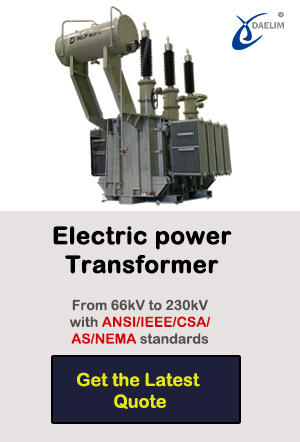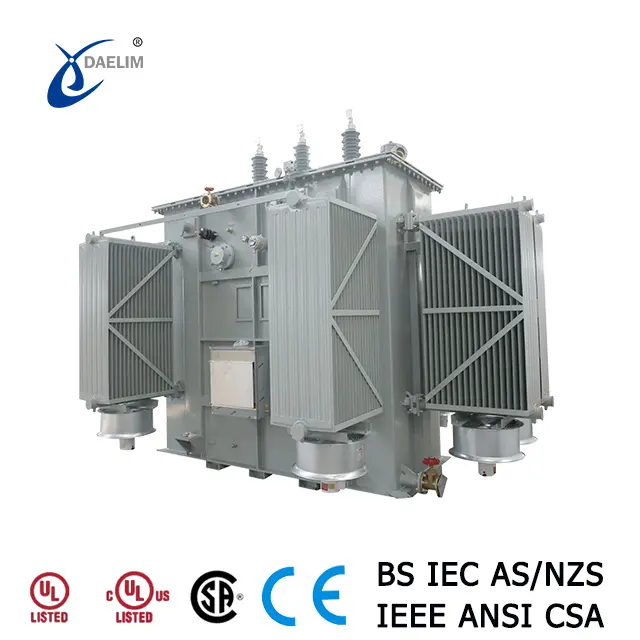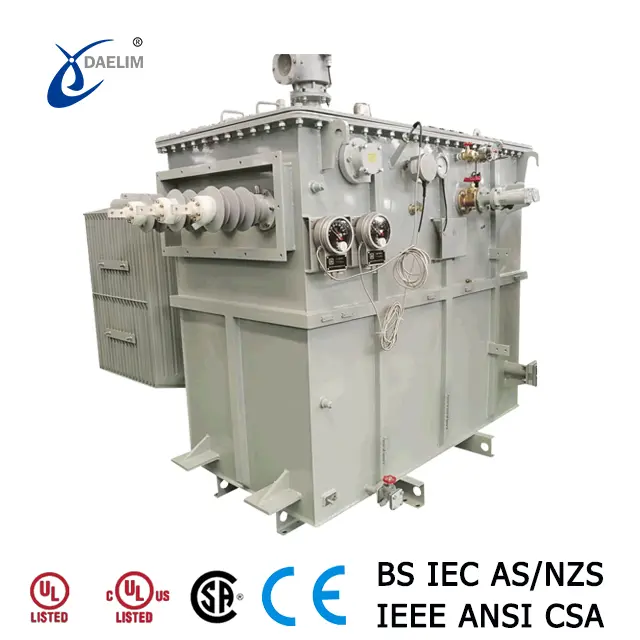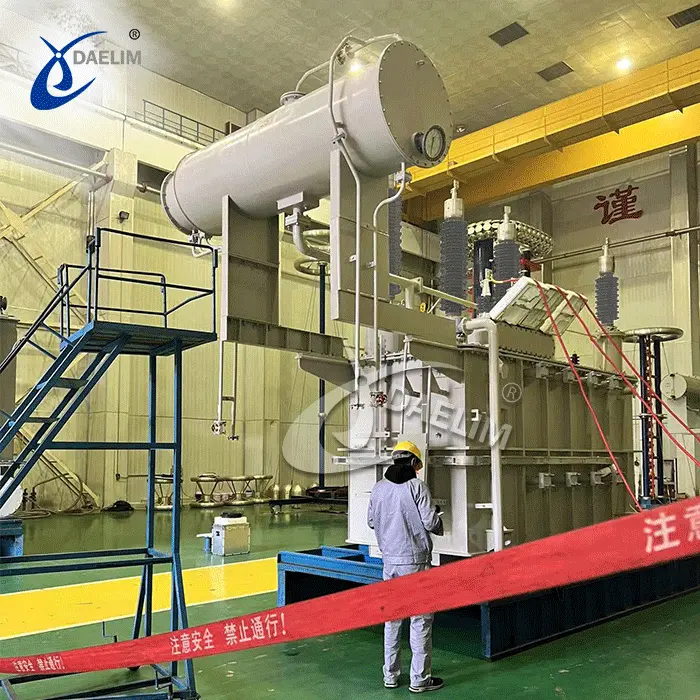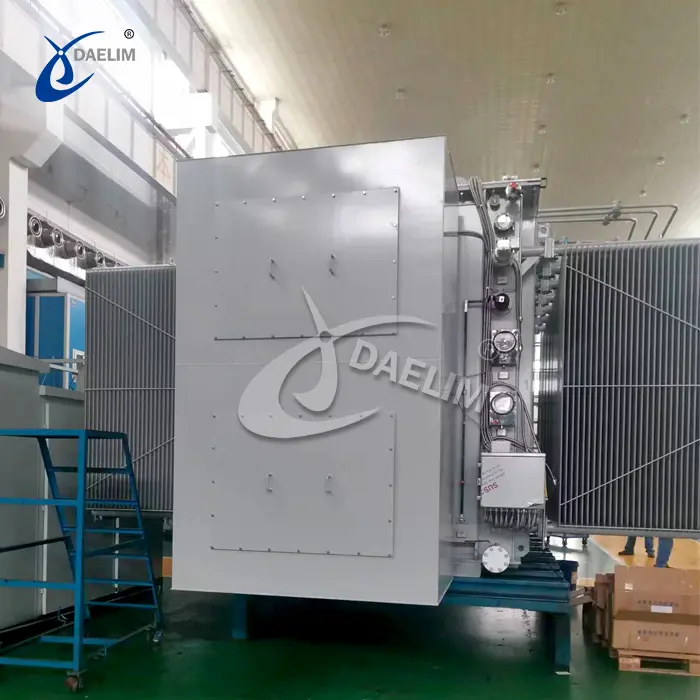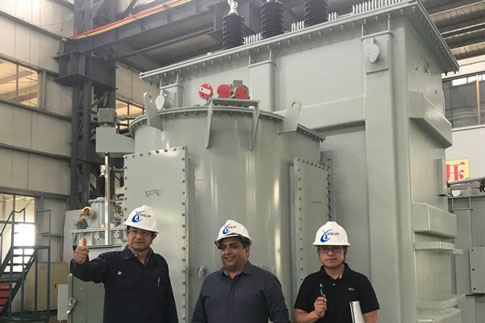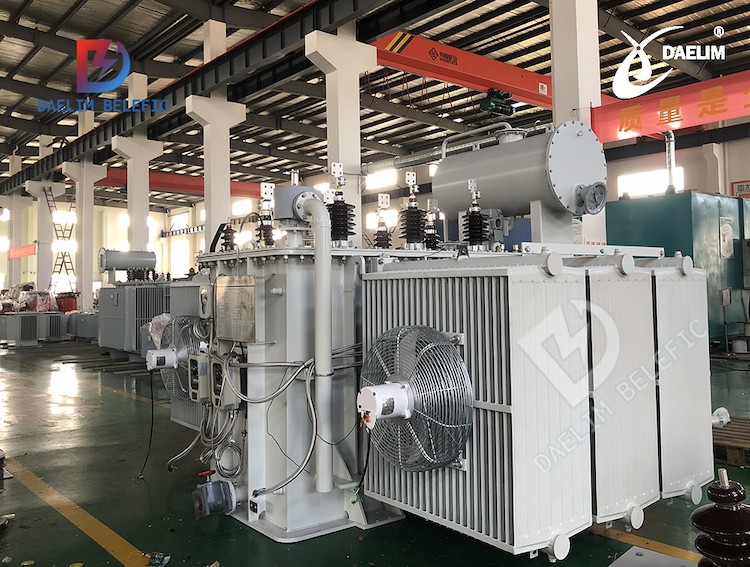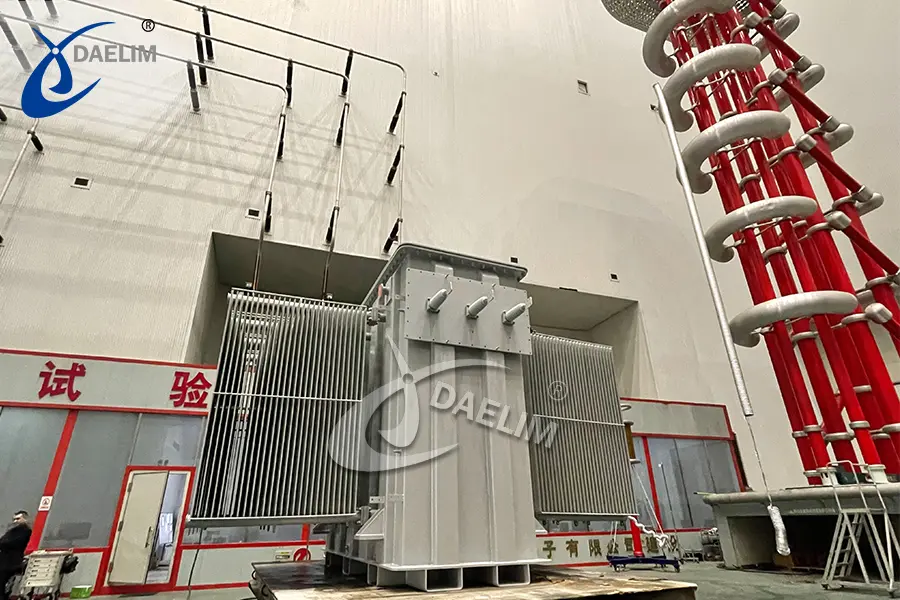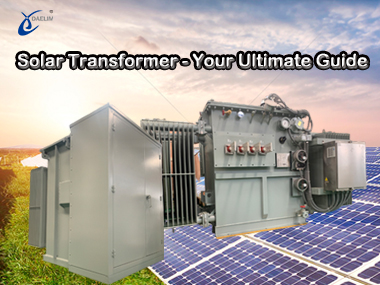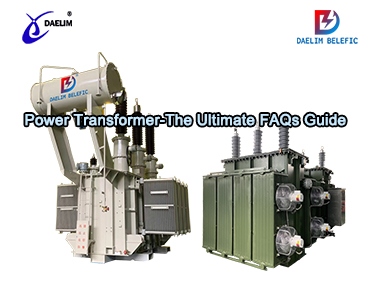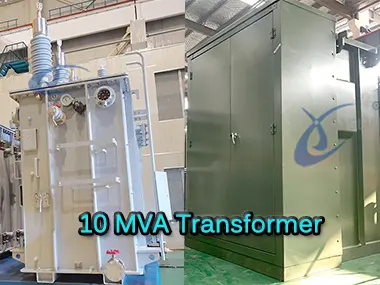20 MVA Transformer: The Ultimate FAQs Guide - Daelim
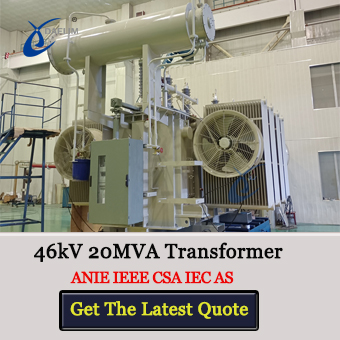 Purchasing transformers is a big deal, especially in the commercial and industrial sectors. However, choosing the right type of transformer can be a daunting task. But with the right information, you can make an educated decision that will serve your organization for many years.
Purchasing transformers is a big deal, especially in the commercial and industrial sectors. However, choosing the right type of transformer can be a daunting task. But with the right information, you can make an educated decision that will serve your organization for many years.
When it comes to transformers, one of the most popular types is the 20 MVA transformer. This guide will answer some of the most frequently asked questions about 20 MVA transformers.
What is MVA Power?
Before you understand what 20 MVA transformers are, it's important to know what MVA power is all about.
MVA or megavolt-amperes is the unit used to measure the apparent power in a circuit. It's a product of the voltage and current in a circuit. In simple terms, it's the amount of power that a transformer can handle.
This means that power is associated with a particular circuit's current and voltage. In terms of terminologies, power is the product of voltage and current, hence the term VA or volt-amperes.
However, the current and voltage are not in phase in most electrical systems. This means there's a difference in the timing at which the two waveforms peak. The resultant power is then called apparent power. This is what is usually referred to as MVA.
Learn more: The Ultimate Guide to 5mva Transformers
Electric companies commonly use MVA when installing transformers, substations, and other similar electrical devices. Through MVA, they can determine the size of equipment needed as well as the capacity.
To calculate the MVA of a transformer, other measuring units are involved, such as KVA (kilovolt-amperes) and MVA (megavolt-amperes). KVA is usually used for single-phase circuits, while MVA is commonly used for three-phase circuits.
To put things into perspective, 1,000 KVA equals 1 MVA of power. Therefore, installing transformers will usually require professionals to check the substation's capacity before deciding on the size of the equipment. However, doing so will ensure a safer installation as every facility or building has different electrical needs, thus, requiring compatible MVA power.
Read more: How To Purchase A 1000kva Transformer In 2022
In addition, MVA is also used for measuring the amount of electricity an establishment requires. A rule of thumb is that it should match the MVA power capacity of the substation. Otherwise, you might experience brownouts or blackouts in your area.
By matching the MVA power capacity with the substation reduction power loss, you can reduce the amount of heat emitted by the transformer. The lower the capacity, the less heat will be produced, resulting in a stable and controlled power state.
What is a 20 MVA Transformer?
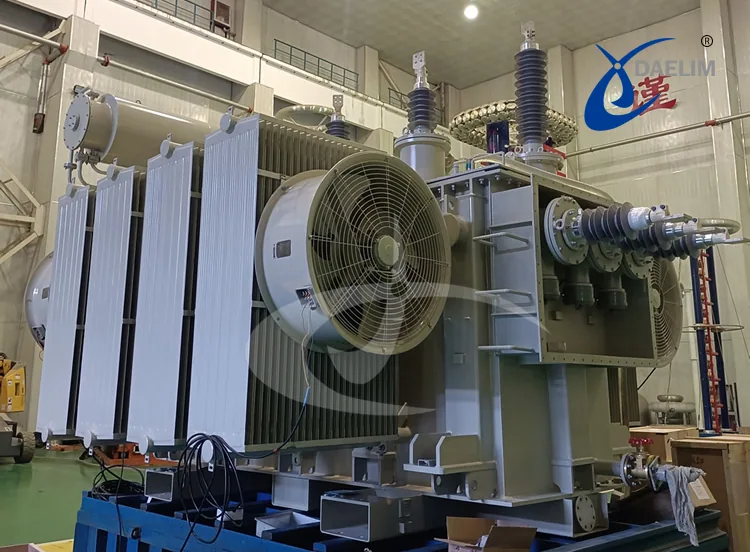
Now that you know what MVA power is, let's move on and answer the next question: what is a 20 MVA transformer?
A 20 MVA transformer is an electrical device that helps in the regulation and distribution of electricity. It steps up or steps down the voltage as needed. This type of transformer is named because it has a rating of 20 megavolt-amperes.
20 MVA to kVA is 20000 kVA.This means that it can handle 20,000 kVA or 20 MVA of power, which is a lot. 20 MVA transformers are usually used in high-voltage applications where there's a need to transfer large amounts of electrical power.
Two power ratings start with the letter "M," which are MVA and MW—the latter being short for megawatt. You might get confused and mix the two, but they are different.
Simply put, MVA is a product of voltage and current. On the other hand, MW is a unit of measurement for real power that equals one million watts. It's also the power factor that's considered during manufacturing.
To determine the power needed to operate a particular device, you'll have to use the product of the voltage and current. Therefore, you will see multiple power factors with the corresponding rating. For example, if you need to operate a machine that requires 1,500 watts of power at 240 volts, you must multiply 1500 by 240.
After obtaining the answer, you must multiply it again by the power factor. The higher the number of watts, the higher the power factor. In this example, the power factor is 0.8. Therefore, you will need 1,920 watts or 2 kilowatts to operate the machine.
In the case of a 20 MVA transformer, this type of transformer can supply power of 16 MW—given that the power factor is 0.8.
Try for free: 10.5MVA-13.8/2.4kV Substation Transformer
What are the Types of 20 MVA Transformers?
There are different types of 20 MVA transformers that you should be aware of, and these are the following:
Oil Filled Transformer
Substation Type Transformer
Furnace Transformer
Each type of transformer has advantages and disadvantages that you need to consider.
You may enjoy: 3 Phase Pad Mounted Transformer
Oil Filled Transformer
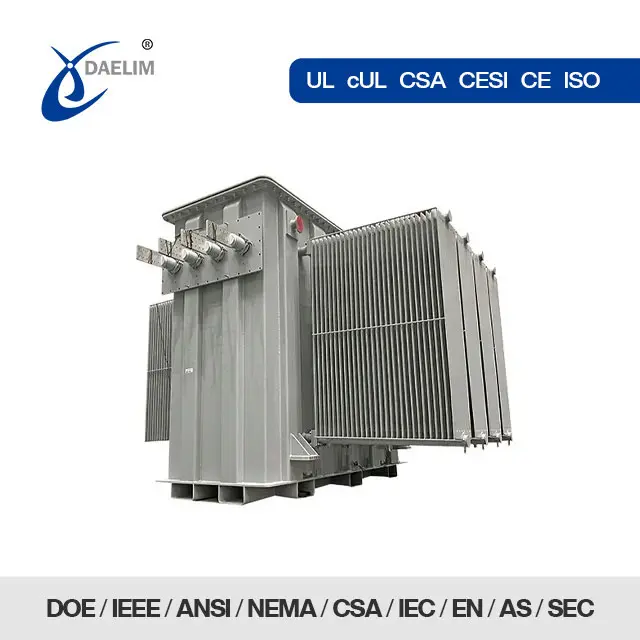 Oil-filled transformers are the most common type of transformer. As the name suggests, it uses oil for its cooling and insulating system. In addition, the oil helps in the heat dissipation of the transformer.
Oil-filled transformers are the most common type of transformer. As the name suggests, it uses oil for its cooling and insulating system. In addition, the oil helps in the heat dissipation of the transformer.
One advantage of oil-filled transformers is that it has a long lifespan. With proper maintenance, it can last for decades. It's also less likely to experience faults or failures.
However, one drawback of using an oil-filled transformer is it's prone to leaks. The oil can spread and damage the surrounding area if there's a leakage. It can also be a potential fire hazard.
You may enjoy: 50 MVA Transformer
Substation Type Transformer
The substation transformer is a type of transformer commonly utilized in the American and Australian markets. It is primarily employed in power distribution systems, designed to handle high voltages up to 35 kV and capacities of up to 20 MVA. These transformers are essential for stepping down high transmission voltages to lower levels suitable for distribution within the power network..
Get it now: 20 MVA Sbustation Transformer
Furnace Transformer
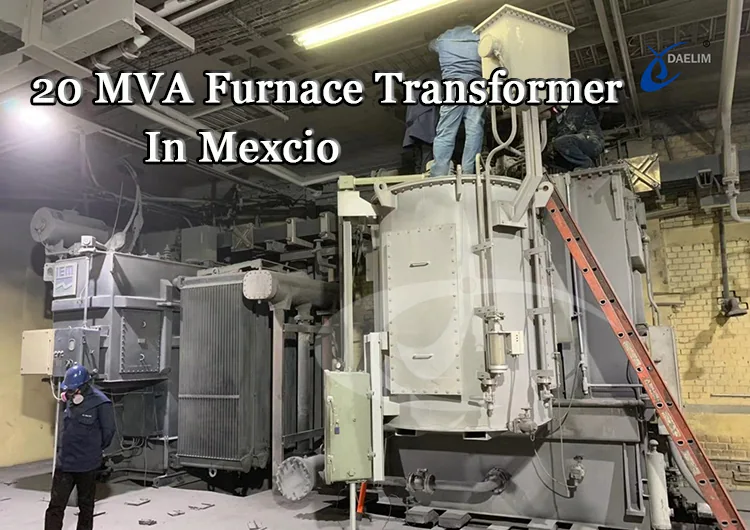
Furnace transformers are used in high voltage applications where there's a need to transfer large amounts of electrical power.
Electric furnace transformers are more expensive than the other types of transformers. But they are also more energy efficient and can last for a longer period of time.
The downside of furnace transformers is that they are more difficult to maintain. If not properly maintained, they are likely to experience faults or failures.
Read more: Basic introduction to electric furnace transformer
20 MVA Transformer Price
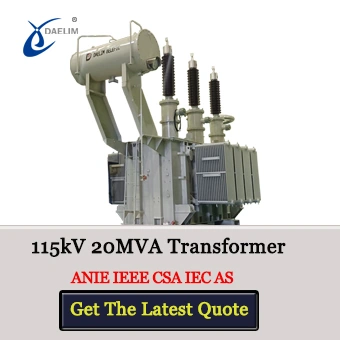 20 MVA transformer price ranges from $85,000 to $250,000. The higher the voltage level, the price of the 20 MVA transformer will be higher, and the copper winding is higher than the aluminum winding. As the price of raw materials fluctuates, the price of a 20 MVA transformer will also rise or fall. Of course, the transformer prices of different manufacturers will also be different, and the prices of well-known brands will be much higher. The length of the warranty period also affects the 20mva transformer price.
20 MVA transformer price ranges from $85,000 to $250,000. The higher the voltage level, the price of the 20 MVA transformer will be higher, and the copper winding is higher than the aluminum winding. As the price of raw materials fluctuates, the price of a 20 MVA transformer will also rise or fall. Of course, the transformer prices of different manufacturers will also be different, and the prices of well-known brands will be much higher. The length of the warranty period also affects the 20mva transformer price.
If you want to know the exact price of the 20 MVA transformer you need to buy, please send your transformer technical requirements to [email protected], Daelim team will give you the price of the transformer within 24 hours.
Reading more: The Ultimate Guide To 30 MVA Transformer
20 MVA Transformer Dimensions
The following table is the specific dimensions of the 24.9kV 20 MVA transformer designed and produced by Daelim according to IEEE standards.
| Height(mm) | Depth(mm) | Width(mm) | Insulating oil(kg) | Total weight(kg) |
| 5800 | 4280 | 1900 | 15980 | 61460 |
20 MVA Transformer Data Sheet
The following table is Daelim 20 MVA transformer datasheet.
| Provider | DAELIM | Basic Impulse Level Rolled Up | IEEE C57.12.90 |
| Model | S-20000-24.9-13.8 | - Primary winding | 150kV |
| Type | Oil immersed | - Secondary winding | 95kV |
| Rules | IEEE C57.12.00 IEEE C57.12.90 | HV side tap range | ±2x2.5% |
| Frequency | 60Hz | Manufacturing Standard | IEEE |
| ENVIRONMENTAL CONDITIONS OF THE INSTALLATION PLACE | ACCESSORIES | ||
| Maximum ambient temperature | 40°C | Buchholtz relay | Yes |
| Minimum ambient temperature | -40°C | Dial-Type Liquid Thermometer | Yes |
| Average daily maximum temperature | 25°C | Pressure-Vacuum Gauge | Yes |
| Maximum height of sea level | 1000m | Oil level indicator with contacts | Yes |
| GENERAL CHARACTERISTICS | Tap changer in HV side | NLTC ±2×2.5% | |
| Standards used in manufacturing: | IEEE Std. C57.12.00 | Welded or detachable radiators | Detachable |
| SERVICE TECHNICAL CHARACTERISTICS | Pressure relief device | Yes | |
| Primary winding tension | 24.9kV | Drain and sampling valve | Yes |
| Secondary winding tension | 13.8kV | OIL PROPERTIES | |
| TECHNICAL CHARACTERISTICS | Commercial designation | China petro | |
| Type of cooling: | ONAN | Type | Mineral oil type II |
| -Power ONAN | 20000KVA | Rule | ASTM D3487 |
| Temperature rise coiled to the installation temperature (coiled - oil - hottest point) | 65ºC - 65ºC - 80ºC | PCB | NO |
| - Primary winding | 24.9kV | Routine Tests (ANSI C.57.12.90) | IEEE C57.12.90 |
| - Secondary winding | 13.8kV | Warranty | |
| Winding Connection | Dyn1 | 2 year | Ok |
20 MVA Transformer Nameplate
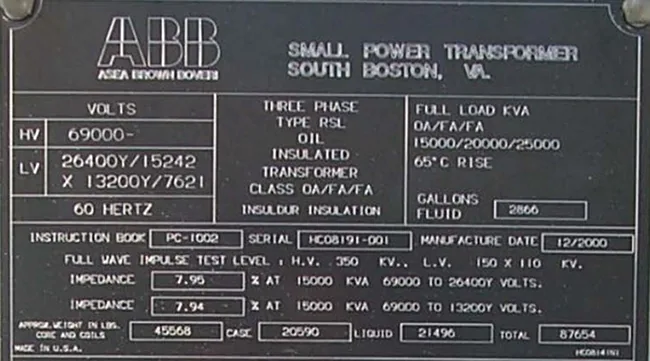
The picture above shows an ABB 20 MVA transformer nameplate. From this 20 MVA transformer nameplate, we can know that the high and low voltage of this transformer is 69kV and 26.4Y/15.242kV; 13.2Y/7.621kV. The transformer frequency is 60hz, three-phase type. Oil insulated transformer class OA/FA/ FA, the maximum capacity under different cooling methods is 15MVA, 20MVA, and 25MVA. The impedance value of the transformer is 7.95%. There are many other parameters that can be read from the 20 MVA transformer nameplate.
Learn more about Transformer Nameplate
What is the Meaning of 16/20 MVA of a Transformer?
Transformers are designed to work continuously at about 80% of rated capacity. Therefore, 16/20 MVA is the capacity of the same transformer with and without cooling (full load capacity and the max capacity). Thus, 20 MVA is the full load capacity, while 16 MVA is the continuous rated capacity.
The load capacity is a short-term measurement for real power equal to one million watts. It's also the power factor that's considered during manufacturing. On the other hand, the max capacity is the long-term or thermal measurement for apparent power.
What is Inside a 20MVA Transformer?
A 20 MVA transformer is made up of the following parts:
Core
Windings
Bushings
Tap changers
Oil level indicators
The core of the transformer is made up of thin steel laminations. The windings are coils of copper or aluminum wire that are wrapped around the core. The bushings are made of insulating materials and are used to provide an electrical connection to the transformer.
The tap changers are used to change the voltage of the transformer. The oil level indicators are used to monitor the transformer's oil level.
Keep reading: High Voltage Transformer Guide In 2022
20 MVA Transformer Specification
Here's a sample 20 MVA transformer datasheet and specification:
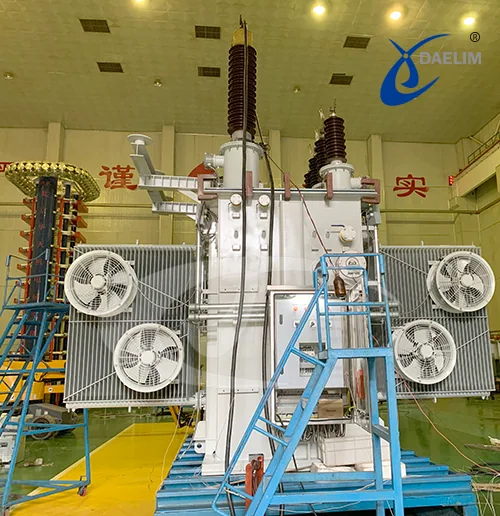
Delivered to:
Year:
Model:
20 MVA Transformer Price: USD 200,000
Application: Power Transformer
Type: Oil-Filled, Dry-Type, or Furnace
Standard: IEC60076
Rated Power: 16/20 MVA (16 000 / 20 000 kVA)
Frequency: 50 Hz
Temperature Rise (Oil/Wind): 55/60
Phase: Three (3)
Cooling Type: ONAN/ONAF
Primary Voltage: 132 kV
Secondary Voltage: 11 kV
Winding Material: Copper
Vector Group: YNd1
Impedance: 11%
Tapping Range: 132+4/-12*1.25%
Tap Changer: OLTC
No Load Loss: 21 KW
On Load Loss: 112.5 KW
Total Weight: 65,036 lbs. (29500 kg.)
Weight of Oil: 13,007 lbs. (5900kg.)
Transport Weight: 51,808.63 lbs. (23,500 kg.)
Accessories: Standard Configuration
Remarks: N/A
What is the Weight of a 20 MVA Transformer?
The weight of a 20 MVA transformer varies depending on the type of transformer. For example, oil-filled transformers are typically heavier than dry-type transformers.
The weight of a 20 MVA transformer also varies depending on the cooling system. As a result, ONAN transformers are typically heavier than ONAF transformers. For example, the 20 MVA transformer weight of an oil-filled transformer is 65,036 lbs. (29500 kg.)
The weight of your 20 MVA transformer will also vary depending on the accessories included. Standard accessories typically add 1-2% to the total weight of the transformer, while optional accessories can add up to 5%.
Try for free: How Much You Know To Purchase The 12.5 MVA Transformer In 2022
What are the Most Critical Factors When Buying a 20 MVA Transformer?
There are several factors that you should consider when buying a 20 MVA transformer:
Voltage
The first factor is the voltage. The voltage of a transformer is the difference in voltage between the primary and secondary winding. The most common voltages for 20 MVA transformers are 132 kV and 25 kV. Of course, there are other voltages, such as 46kv, 24.94kv, and so on.
Learn more: 10mva Transformer: The Ultimate FAQs Guide - Daelim
Dimensions
The third factor to consider is the 20 MVA transformer dimensions. The dimensions of a transformer vary depending on the type of transformer, the cooling system, and the accessories.
For example, the dimensions of the 20 MVA oil-filled transformer are typically 8'6" L x 5' W x 6' H. The dimensions of a dry-type transformer are typically 6' L x 4' W x 3.5' H.
The 20 MVA transformer dimensions will also vary depending on the accessories included. Standard accessories typically add 1-2% to the total length of the transformer, while optional accessories can add up to 5%.
Therefore, you need to consider the size of the installation space before purchasing a 20mva transformer to ensure that the transformer can be smoothly installed in the reserved space.
Cooling System
The fourth factor to consider is the cooling system. The cooling system of a transformer is responsible for removing the heat generated by the transformer. The most common cooling systems are air-cooled and water-cooled.
Air-cooled transformers are typically used in applications where the temperature is not too high, and the environment is not too dusty. On the other hand, water-cooled transformers are typically used in applications where the temperature is very high or the environment is very dusty.
Rated Current
The fifth factor to consider is the rated current. The rated current of a transformer is the product of the squared value of the rated load and the secondary rated current—it's quoted in VA. Standard values are 2.5-5-10-15-30 VA. It's also possible to choose values above 30 kVA as long as it's in accordance with the application case.
Load Loss
Transformer load losses are caused by resistive and reactive components in the transformer windings. The primary winding has a higher resistance than the secondary winding, so it has a higher percentage of resistive losses. The secondary winding has a higher reactance than the primary winding, so it has a higher percentage of reactive losses.
The reactance of the windings also affects the load losses. The higher the reactance, the higher the percentage of reactive losses. The total load losses are a combination of resistive losses and reactive losses.
The transformer's efficiency is equal to the ratio of the output to the input powers. The output is the amount of power delivered to the load. The input power is the power that is required to operate the transformer.
The efficiency of a 20 MVA transformer typically ranges from 95% to 99%. The higher the efficiency, the less power is required to operate the transformer.
Learn more about Transformer Efficiency
The impedance voltage of a transformer is the voltage that is applied to the primary winding. The impedance voltage typically ranges from 2% to 10%.
The impedance voltage is important because it determines the amount of current that flows through the transformer. The higher the impedance voltage, the less current flows through the transformer.
There are two main types of transformer structures: shell type and core type. The structure of a transformer affects the size, weight, and cost of the transformer.
Shell-type transformers are typically smaller and lighter than core-type transformers. They are also typically more expensive. Core-type transformers are typically larger and heavier than shell-type transformers. They are also typically less expensive.
The choice of transformer structure depends on the application. Shell-type transformers are typically used in applications where size and weight are important factors. Core-type transformers are typically used in applications where cost is an important factor.
Insulation Class
Finally, the insulation class of the 20mva transformer is an important factor to consider. The insulation class of a transformer is the amount of heat that the transformer can withstand without being damaged.
The most common insulation classes are A, B, F, and H. Class A transformers can withstand temperatures up to 130℃. Class B transformers can withstand temperatures up to 155℃. Finally, class F transformers can withstand temperatures up to 180℃.
Related Products
Related Article
20mVA Furnace Transformer, Mexico
Installation in 2018, is used to supply power to an electric furnace, which lowers the high voltage to the furnace-required lower voltage. It was designed according to client's request.
13.8 kV 10.5 MVA Substation Transformer for Ecuador
A customer from Ecuador contacted Daelim Transformer for a 10.5MVA substation transformer (13.8kV high voltage, 2.4kV low voltage). Daelim Transformer provided a customized solution, conducted virtual factory tours, ensured rigorous quality control via video inspections, and offered post-delivery online training and ongoing support, fostering a successful partnership.
20MVA Power Transformer for the United States
This project involves the development of a 20 MVA three-phase power transformer tailored for the United States market. The primary voltage is 24.94kV, and the secondary voltage is 4.16kV, indicating it functions as a step-down transformer. The design and production fully comply with IEEE C57.12.00 standards and have passed third-party UL team testing. All accessories also adhere to IEEE standards. FR3 vegetable oil serves as the insulating liquid for the transformers.
Solar Transformer, Get The Best Price
Solar energy is the most abundant energy source on earth, and contemporary solar energy can be used to produce other renewable energy sources. We can convert solar energy into electricity. At present, there are two main conversion forms in the world, one is solar photovoltaic power stations, and the other is solar thermal power stations. Whether it is photovoltaic power generation or solar thermal power generation, solar transformers are used.
Power Transformer-The Ultimate FAQs Guide
Power transformers are one of the most important equipment in the electrical power system. If you have any questions regarding power transformers, you'll find all of the answers you're looking for here.
10mva Transformer: The Ultimate FAQs Guide - Daelim
A 10mVA transformer is a distribution transformer that can help generate electricity supply to larger industries and manufacturing plants. Volt Amperes (VA) is the measurement unit for the amount of electrical load in engineering standards.

